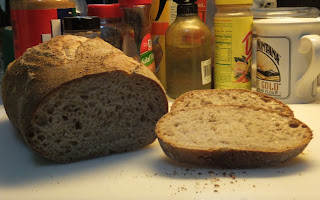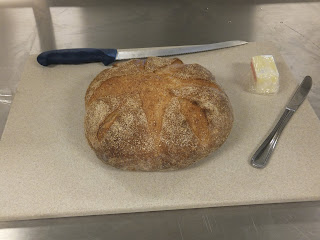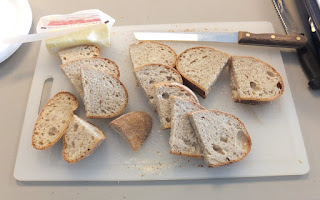 The plain and simple explanation is that I used 40% bolted Turkey Red flour in this loaf. I still have some left and I'm making an effort to use it more often. I bought a 10 pound bag of some Green River stoneground whole wheat flour that I found at Costco and I am trying not to open the bag until I finish up at least one the two containers that never seem to empty out whenever I buy new flour. Something has got to give sooner or later.
The plain and simple explanation is that I used 40% bolted Turkey Red flour in this loaf. I still have some left and I'm making an effort to use it more often. I bought a 10 pound bag of some Green River stoneground whole wheat flour that I found at Costco and I am trying not to open the bag until I finish up at least one the two containers that never seem to empty out whenever I buy new flour. Something has got to give sooner or later.Besides working with 40% whole wheat in this loaf, I also stretched out the proofing time. I had been proofing for three hours after pulling a loaf out of the fridge but I waited for 4 1/2 hours on this one and it appears to have worked out. I also had the opportunity to slash the loaf with a rather dangerous edged scalpel and that was not bad work for using the knife for the first time in several months. It still takes practice. I didn't find the practical limit of hydration that matches my shaping skills with this loaf but It seems to have a nice but not spectacular crumb.There'll be more to practice next week.
Starter
150 g at 90% hydration
Main Dough
260 g bread flour
140 g bolted Turkey Red flour
280 g water at 90F
10 g kosher salt
All of starter
There's more and more green showing up in the flower beds. While the peonies are still holding close to the ground, the day lilies are sprouting up quickly. The daffodils still haven't recuperated from the recent snowfall but there should be blooms by Tuesday. My garlic seems to have survived the winter and I've pulled the wheat straw mulch off to give the leafs a chance to get some sunlight. The mulch will have to go back on Sunday night when the temperatures are expected to go back below freezing. The oregano and sage plants look like they'll pull through but that rosemary plant is quite hopeless. My lawn is an embarrassment and sorely in need of investment of expensive amendments which don't seem to be in its future. More than fertilizers and chemicals, it needs regular rainfall to recover from last year's drought conditions.
Unusual page view origins over the past week or so include Greece, Panama, and Romania.
Comments, humor, and questions are welcome.


















